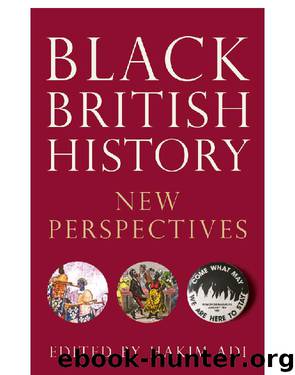Black British History by Unknown

Author:Unknown
Language: eng
Format: epub
ISBN: 9781786994288
Publisher: Book Network Int'l Limited trading as NBN International (NBNi)
Published: 2019-03-10T16:00:00+00:00
While it is unclear exactly which group began to paper the town of Smethwick with flyers emblazoned with the incendiary slogan ‘If you want a nigger for a neighbour, vote for Labour’, the local popularity of the sentiment brought national attention to Griffith’s campaign and to the town of Smethwick. Although Griffiths did not take credit for openly adopting the slogan, which ultimately became synonymous with his campaign, as white constituents in his district embraced the underlying idea of the openly racist message captured in the slogan, Griffiths did little to distance himself from the sentiments. In fact, in an interview with The Times, he suggested that those who adopted such views did not deserve a rebuke since the slogan represented what he described as ‘a manifestation of popular feeling’.17
Even though Peter Griffiths entered the halls of parliament as an outcast because of the racist anti-immigrant views that he championed as a candidate for Smethwick in the general election of 1964, when Malcolm X came to Britain in February 1965, Griffiths was one of the people that he desired to meet.18 This meeting never happened. However, accompanied by a team from the BBC, Malcolm X made a point of documenting his face-to-face confrontation with the place that had brought Griffiths to political infamy. More specifically, during his visit, Malcolm X journeyed to Marshall Street in Smethwick, a place that flagrantly displayed an open hostility towards what was described at the time as the presence of ‘coloured immigrants’. Smartly dressed, wearing his signature browline glasses, BBC cameras captured footage of Malcolm X as he strolled down Marshall Street. Two of the most iconic frames from this footage depict him standing before a sign indicating his location on Marshall Street and another as he stood peering through a window at a for-sale sign posted on a property in the street. These images were not accidental. They functioned as part of a larger critique that Malcolm X intended to make about the state of race relations and the political economy of racism affecting black and Asian communities in Britain during the mid-1960s. As Malcolm X took questions from reporters who followed his short trek down Marshall Street, he explained that he had taken a detour from a speaking tour, which included stops at the London School of Economics and Birmingham University, to visit Smethwick because he had been disturbed by ‘reports that the coloured people in Smethwick are being treated badly’. He explained, ‘I have heard they are being treated as Jews were under Hitler,’ and suggested to reporters that people of colour in the area should work proactively to combat such treatment and not ‘wait for the fascist elements in Smethwick to erect gas ovens’.19 In doing so, he issued a call for direct resistance and strategic organising in the face of white supremacy, racial exclusion and discrimination.20
Download
This site does not store any files on its server. We only index and link to content provided by other sites. Please contact the content providers to delete copyright contents if any and email us, we'll remove relevant links or contents immediately.
Kathy Andrews Collection by Kathy Andrews(11726)
The remains of the day by Kazuo Ishiguro(8817)
Paper Towns by Green John(5087)
Spare by Prince Harry The Duke of Sussex(5072)
The Body: A Guide for Occupants by Bill Bryson(4974)
Industrial Automation from Scratch: A hands-on guide to using sensors, actuators, PLCs, HMIs, and SCADA to automate industrial processes by Olushola Akande(4971)
Machine Learning at Scale with H2O by Gregory Keys | David Whiting(4171)
Be in a Treehouse by Pete Nelson(3942)
Never by Ken Follett(3787)
Harry Potter and the Goblet Of Fire by J.K. Rowling(3772)
Goodbye Paradise(3725)
Into Thin Air by Jon Krakauer(3308)
The Remains of the Day by Kazuo Ishiguro(3293)
The Cellar by Natasha Preston(3259)
The Genius of Japanese Carpentry by Azby Brown(3223)
Fairy Tale by Stephen King(3216)
120 Days of Sodom by Marquis de Sade(3177)
Drawing Shortcuts: Developing Quick Drawing Skills Using Today's Technology by Leggitt Jim(2996)
The Man Who Died Twice by Richard Osman(2995)
